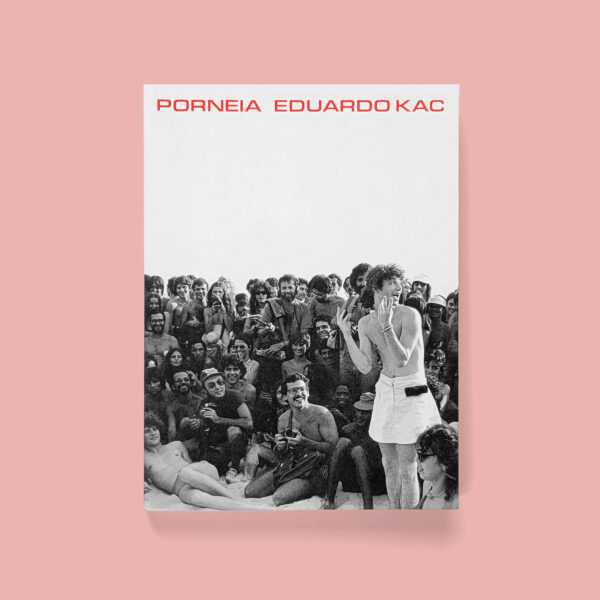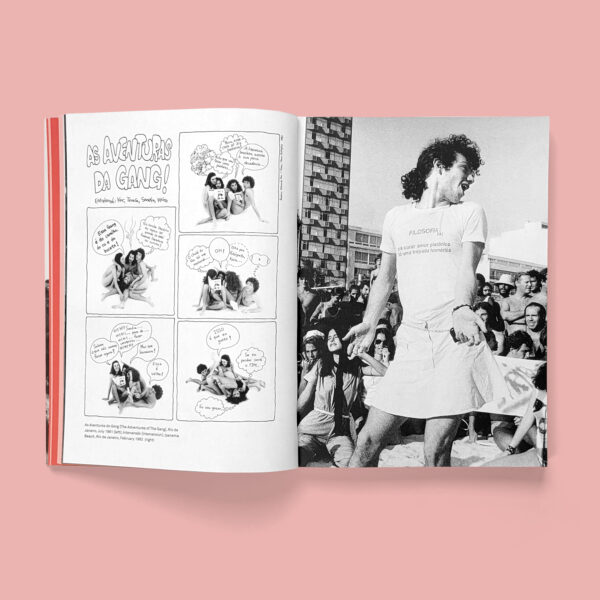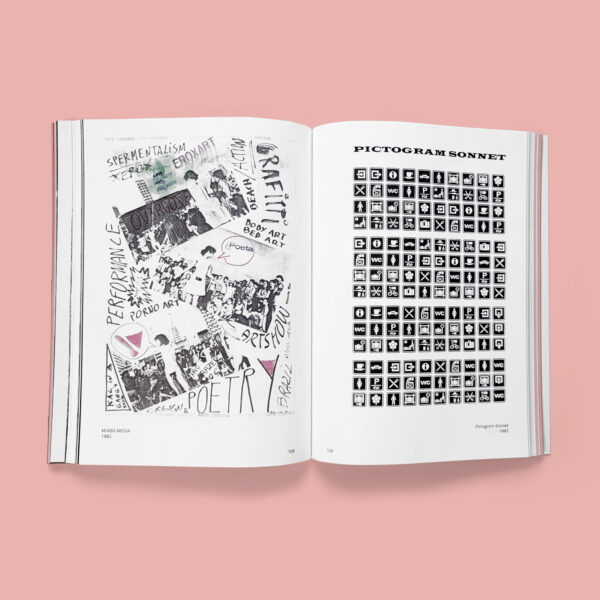
Happy publication day to Eduardo Kac’s Porneia! To celebrate, Nightboat’s Director & Publisher Stephen Motika speaks to Eduardo about the Porn Art Movement, Brazilian history, his teenage years at Ipanema Beach, the history of visual poetry, and more! Take a look below.
_____________________________________
Can you talk about how the Porn Art Movement started and a bit about how you became involved with the movement?
By late 1979 I felt that art and poetry in Brazil had ossified around modernist narratives, and that it was time to launch a new movement, this time focused on the body as a meaning matrix. My idea was to simultaneously foster formal experimentation and political activism centered on what I then described as “pansexuality”. By this I meant that all forms of non-normativity would have a voice. In sum, a movement to end the explicit or implied notion of a universal subject, to erase dichotomies and hierarchies between popular and erudite cultural forms, and to move unconstrained gender expression center stage. To achieve these goals, the movement would subvert the semiotics of pornography and place it at the service of liberation and imagination. I identified potential collaborators and launched the movement with an event on Ipanema Beach in February 1980.

What was the significance of pornography as a theoretical idea and metaphor for liberation against the Brazilian dictatorship as utilized in the Movement? What do you most want a contemporary reader to know about life in Brazil in 1980?
There’s an enormous gap between the notion of “porn art” today, in the age of the Internet, and the radical aesthetics of “porn art” in Brazil in 1980. Not only was there a military dictatorship, in power since 1964, but the constitution—which was from the 1940s, when another dictator ruled— banned “obscenity.” To keep things in perspective, the current Brazilian Constitution was promulgated in 1988 and the first real democratic election, since the 1964 military coup, took place in 1989. So, the period between 1980 and 1982, when the Movement sustained organized activities, was exceptionally turbulent, with the extreme right wing of the military carrying out regular bomb and arson attacks against civilian targets. The violence, conservatism, and hierarchization had been internalized by the population. So, it was necessary not only to oppose the illegitimate form of government but also work to undo the internalized damage caused by decades of dictatorship. If today the phrase “porn art” I coined in 1980 has gained currency, and new meanings, at the time it provoked cognitive dissonance, being equally rejected by progressives and conservatives. In 1980, while in the US there was already a pornographic industry, this did not exist in Brazil. Pornography, in 1980, had no open social expression in Brazil. “Porn art” was a new intellectual category, without precedent, and we launched it to turn the table, create new aesthetic possibilities, and point the way towards a more open future.
Your work as part of the Porn Art Movement, includes a lot of poetry, from the yell to visual poems to manifestos and graffiti. There are so many precedents in this work, both Brazilian and the global avant-garde; could you talk a little about the poets and writers who influenced you during this time of your life? How was it to return the poems nearly 40 years later to prepare the English-language translations for this volume?
If we talk about precedents, we also need to say that there are countless precedents to both the Brazilian and the global avant-garde. For example: it is commonly believed that visual poetry starts in Brazil in the 1950s, but this is incorrect. There are examples of visual poetry in Brazil in every century before the twentieth century, starting with the Baroque poet Gregório de Matos. In fact, there are also examples of visual poetry in Brazil in every decade of the twentieth century before the 1950s. This material would make a remarkable anthology. Concerning precedents to the global avant-garde, the earliest examples of visual poetry were created by Simmias of Rhodes before 300 BCE. His carmina figurata include the well-known “Wings”, “Egg”, and “Hatchet”. There’s continuity from Simmias of Rhodes onwards, in a tradition that includes Optatianus (4th century CE), the medieval Jewish tradition of micrography, European Baroque poets (as captured in Ana Hatherly’s phenomenal book “A Experiência do Prodígio”), all the way to Apollinaire, Cummings, etc. So, yes, there are many precedents, but the global avant-garde is not the starting point. The work I developed in the context of the Movimento de Arte Pornô (MAP) shares the same ancient sources of the global avant-garde. I don’t work with the concept of “influence” for this reason: at the end of the day, we all share the same ancient sources. Think of Laura Swift’s remarkable recent edition of Archilochus’s poems and the birth of lyric poetry. Archilochus flourished c. 650 BCE and is the earliest known poet to have written, not about heroic feats, but his own emotions and experiences. Having said that, my Pornograms are very different from these traditions, as in this series the actual living body is the written text or the writing medium, depending on the work. The yellpoems were focused on transforming the stigmatized and negative charge of words in common discourse into positive meanings. Each body of work I developed in the MAP had its own creative vectors. To return to the poems nearly 40 years later was challenging in several ways. The research in my archive was significant and took several years. But the most challenging of all was the translation. The original works mix slang with erudite references, not to mention context-specific allusions. English and Portuguese syntax are fairly different. It took me many years to produce translations and write notes that effectively convey the meanings and the revelry of the originals. All in all, nine years. I’m extremely happy with the result.

You were a teenager, ages 17-19, when you were involved with the movement. What kind of kid were you when you arrived at Ipanema Beach in February of 1980? The tenor of this body of work seems quite different between your decades of work as a bio and digital artist. What do you think of the relationship between the Porn Art work and your mature work?
At the time I was a skateboarder and did body surfing. I also played basketball. I lived by the motto “mens sana in corpore sano.” Even though in intellectual circles sports were generally looked down at, I thought that a balance between the physical and the mental was key. I’ve always read a lot, since I was a little boy. As a child I spent all my allowances buying and reading encyclopedias, which were sold as fascicles in newsstands. Languages were also important to me, as my parents were polyglot. As a teenager, I rigorously read poetry from different countries and traditions, and also studied art from the impressionists onwards. Just before launching the MAP I was an editor at a poetry magazine. Concerning the relationship between the Porn Art work and my mature work, I’d say that a clear thread that connects them is the central role of language and the body in my practice. Most importantly, and independently of the specific material solution of this or that work, I still have the same spark and curiosity that I had when I was 17.
As I developed it, the Porn Art Movement dissolved the notion of a “universal subject.” All voices had equal weight. This same principle, of undoing ontological hierarchies, I pushed further in my Bio Art, which focused on decentering the human. My current work projects the existence of new modes of subjectivity, viewers I don’t have yet—homo spaciens, denizens of space in a multiplanetary society. Cosmic pride!
One of the things I love the most in this body of work is the sure range of mediums and materiality, from performance to mimeo publications and artworks created from scavenged materials. Some of the pieces were very ephemeral, which made it a challenge to archive and document. Can you talk about your use of genres and mediums at the time and how you went about building the archive of images that are reproduced in Porneia?
Most of what I did between 1980 and 1982 was to be performed, printed, or posted. The goal was to reach out. Performance involved immediacy and local audiences. Printed publications circulated. Mail art could be interactive, extended the work to international audiences, and also enabled insertion into alternative networks. As a result, originals were left behind and many did not survive. So, to prepare the book, many works had to be scanned from the printed publications. In some cases, when I did not have the original or the publication in my archive, it was necessary to research institutional archives and obtain the work there. The whole project took nine years. The yellpoems were written for performance, having as one of their goals the transformation of slurs into positively-charged words (what is now known as ‘reclamation’). I made the color photocopies against the grain, by using pre-printed wrapping paper, since actual color photocopiers were not available. The typewriter work preceded my digital debut, but also allowed me to create typescripts for pre-visualization prior to programming. The book includes one of my earliest digital works, Geometria do Êxtase (Geometry of Ecstasy), which I programmed in BASIC at the time, and recently restored. The MAP explored the fusion of elements traditionally perceived to be incompatible, such as geometry and pornography, for example. Indeed, in addition to its political commitment, the MAP was formally experimental. Regarding the archive, I have made a concerted effort, from the beginning, to preserve as much as possible. It was difficult, with my constant moving, but with patience and perseverance, and a little bit of luck, I managed to preserve the most complete archive of the MAP anywhere. Eventually, the archive became an invaluable resource when it came to preparing the book.
**
EDUARDO KAC started making art as a teenager in Rio de Janeiro, when he was a central figure in the Movimento de Arte Pornô (Porn Art Movement) between 1980-1982. He’s now recognized internationally for his telepresence and bio art. Kac’s work has been exhibited internationally and is in the permanent collections of the Tate, London; the Victoria & Albert Museum, London; the Museum of Modern Art in New York; and the Museum of Contemporary Art of São Paulo, among many others. Kac’s work has been featured in contemporary art publications (Contemporary, Flash Art, Artforum), art books (Phaidon, Thames and Hudson, Oxford, MIT Press) and in the mass media (ABC, BBC, PBS, Le Monde, Washington Post, and the New York Times). Kac has received many awards, including the Golden Nica Award, the most prestigious award in the field of media arts and the highest prize awarded by Ars Electronica. His work is documented at www.ekac.org.
